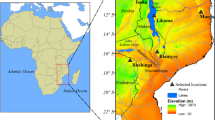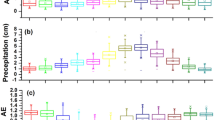Abstract
The high level of chemical compounds in the atmosphere of many West African cities is worrying because of the potential threats to human health and other environmental problems they are known for. However, routine monitoring and adequate control measures are rare due to technical, social and economic problems. This paper analyzed the health and visibility effects of aerosol optical depth chemical species within some West African cities from (2010–2020) using the aerosol optical depth data set obtained from the European Center for Medium-Range Weather Forecasts (ECMWF-UK). The results of the analysis showed that the visual range of the study cities ranged from 4600 to 5600 km, while the potentials of human health effects TPHhe existing in the cities are between 0.9 and 1.2 signifying low visibility and high potential threats to human health. There exist several weak and also inverse correlations between the variability of the aerosol optical depth chemical species in the study cities with a coefficient of determination \({r}^{2}\) ranging from 0.01 to 0.98. This implies that aerosol loads are not uniformly distributed across cities and also come from a plethora of sources across cities. The variability of aerosol optical depth chemical species in the West African cities presented is useful in evaluating and improving the accuracy of the models for aerosol prediction in the region and can assist in the easy determination of aerosol effects in the atmosphere. The total chemical composition of aerosol loads was gauged with acceptable standards limit set by Environmental Protection Agencies to determine the health effects on humans and the results are useful not only in measuring the health implication but also in evaluating safety measures to tackle the effects, while the identified poor visibility in the cities is a clear call for policymakers to step up regulation and design action to tackle the menace of visibility reduction in these cities.



Similar content being viewed by others
Data Availability
Data are available from the corresponding author at reasonable request.
Abbreviations
- ECMWF-UK:
-
European Centre for Medium-Range Weather Forecasts-United Kingdom
- \({{T}}_{{{{PHhe}}}}\) :
-
Toxicity potential of human health effect
- \({\upsigma }_{{{{sp}}}}\) :
-
Light extinction coefficient
- Vr :
-
Visual range or visibility
- 550 nm:
-
The wavelength at which the AOD species were measured
References
Ayua TJ, Tyovenda AA, Sombo T, Tikyaa EV, Igbawua T (2020) Fine Particulate Matter and Heavy Metals Pollution Status in Ambient Air of Some Selected Industrial Sites in Northern Nigeria. J Geosci Environ Prot 8:1–13. https://doi.org/10.4236/gep.2020.8800
Ayua TJ, Tyovenda AA, Tikyaa EV, Balarebe S (2023) Simulation of fine particulate matter dispersion from the Grand Cereals Industry Jos, Nigeria Using a Modified Gaussian Plume Model. Int J Environ Sci Dev 14(2):111–118. https://doi.org/10.18178/ijesd.2023.14.2.1422
Baik NJ, Kim YP, Moon KC (1993) Visibility study in Seoul. Atmos Environ 30:2319–2328. https://doi.org/10.1016/1352-2310(95)00443-2
Balarabe M, Abdullah K, Nawawi M (2015) Long-Term Trend and Seasonal Variability of Horizontal Visibility in Nigerian Troposphere. Atmosphere 6:1462–1486. https://doi.org/10.3390/atmos6101462
Bohren CF, Huffman DR (1998) Absorption and scattering of light by small particles. Wiley, New York
Carre J, Gatimel N, Moreau J, Leandri PJ, J, (2017) Does air pollution play a role in infertility?: a systematic review. Environ Health 16(1):82. https://doi.org/10.1186/s12940-017-0291-8
Chan YC, Simpson RW, Mctainsh GH, Vowles PD, Cohen DD, Bailey GM (2009) Source apportionment of visibility degradation problems in Brisbane (Australia) using the multiple linear regression techniques. Atmos Environ 33:3237–3250. https://doi.org/10.1016/S1352-2310(99)00091-6
Emetere ME, Akinyemi ML, Akinwumi SA (2016) Aerosols loading trends and its environmental threats over Cotonou-Benin. Nat Environ Pollut Technol 15(3):1111
Emetere ME, Okoro EE, Adeyemi GA, Sanni SE (2019) Air pollution assessment: a preliminary study towards citing industry. Proc Manuf 35(2019):681–688
Fawole OG, Cai X, Pinker RT, MacKenzie AR (2019) Analysis of radiative properties and direct radiative forcing estimates of dominant aerosol clusters over an urban-desert region in West Africa. Aerosol Air Qual Res 19:38–48. https://doi.org/10.4209/aaqr.2017.12.0600
Fosu-Amankwah K, Bessardon GEQ, Quansah E, Amekudzi LK, Brooks BJ, Damoah R (2021) Assessment of aerosol burden over Ghana. Scie Afr 14:e00971
Ghan SJ, Wang M, Zhang S, Ferrachat S, Gettleman A, Griesfeller J, Kipling Z, Lohmann U, Morrison H, Neubauer D, Partridge DG, Stier P, Takemura T, Wang H, Zhang K (2016) Challenges in constraining anthropogenic aerosol effects on cloud radiative forcing using present-day spatiotemporal variability. Proc Natl Acad Sci 113:5804–5811. https://doi.org/10.1073/pnas.1514036113,1012
Gnamien S, Yoboué V, Liousse C, Ossohou M, Keita S, Bahino J, Siélé S, Diaby L (2020) Particulate Pollution in Korhogo and Abidjan (Cote d’Ivoire) during the Dry Season. Aerosol Air Qual Res 21(1):200201. https://doi.org/10.4209/aaqr.200226
Lee C, Yuan CS, Chang J, Yuan C (2005) Effects of aerosol species on atmospheric visibility in Kaohsiung City Taiwan. J Air Waste Manag Assoc 55(7):1031–1041. https://doi.org/10.1080/10473289.2005.10464683
Li J, Barbara E, Carlson Y, Yung L, Lv D, Hansen J, Penner JE, Liao H, Ramaswamy V, Kahn RA, Zhang P, Dubovik O, Ding A, Lacis AA, Zhang L, Dong Y (2022) Scattering and absorbing aerosols in the climate system. Nat Rev Earth Environ 3:363–379
Lowenthal DH, Watson JG, Saxena P (2000) Contributions to light extinction during project MOHAVE. Atmos Environ 34:2351–2359
Malm WC, Derek ED, Kreidenweis SM (2000) Light scattering characteristics of aerosols at ambient and as a function of relative humidity: Part II—a comparison of measured scattering and aerosol concentrations using statistical models. j Air Waste Manag Assoc 50:701–709
Max Planck Institute for Chemistry (2016) Emission plumes over West Africa contain a high proportion of organic material. Press and Public Relations, Johannes Gutenberg-Universität Mainz
McClatchey RA, Fenn RW, Selby JEA, Volz E, Garing JS (1972) Optical Properties of the Atmosphere, Rep. AFCRL-72–0497, 3rd Ed., Air Force Cambridge Research Laboratories, Bedford, MA.
McMurry PH (2000) A review of atmospheric aerosol measurements. Atmos Environ 34:1959–1999
Sakaeda N, Wood R, Rasch PJ (2011) Direct and semidirect aerosol effects of southern African biomass burning aerosol. J Geophys Res 116:D12205. https://doi.org/10.1029/2010JD015540
Tan F, Wei YK, Wan SH, Yeap EC, Lim HS, Abdullah K (2015) Investigation of Aerosol Distribution Patterns and Its Optical Properties at Different Time Scale by Using LIDAR System and AERONET. AIP Conf Proc 1657:130001. https://doi.org/10.1063/1.4915232
Tyovenda AA, Ayua TJ, Sombo T (2021) Modeling of gaseous pollutants (CO and NO2) emission from an industrial stack in Kano city, northwestern Nigeria. Atmos Environ 253:118356
Xu X, Zhao W, Qilei Z, Wang S, Fang B, Chen W, Venables DS, Wang X, Pu W, Wan X, Ghao X, Zhang W (2016) Optical properties of atmospheric fine particles near Beijing during the HOPE-J3A campaign. Atmos Chem Phys 16:6421
Yadav AK, Sahoo SK, Patra AC, Thakur VK, Dubey JS, Singh S, Lenka P, Jha V, Kumar AV, Shirin S, Jamal A (2022) enrichment factor and chemical composition of size separated airborne particulate matter of Singrauli Coalfield, India. Aerosol Sci Eng 6:414–436. https://doi.org/10.1007/s41810-022-00155-4
Yang N, Wang Y, Gao P, Zhang Z, Song W, Song X, Liu S, Su H (2023) Impact assessment of heavy metals in PM2.5 of indoor dust in Xi’an, China. Aerosol Sci Eng 7:534–542. https://doi.org/10.1007/s41810-023-00196-3
Yusuf N, Said SR, Tilmes S, Gbobaniyi E (2021) Multi-year analysis of aerosol optical properties at various timescales using AERONET data in tropical West Africa. J Aerosol Sci 151:105625
Acknowledgements
We are sincerely grateful to ECMWF (UK) for making the data available and would equally thank the management of the University of The Gambia for providing a computer set and enabling environment that was used for this study.
Funding
No funding was received.
Author information
Authors and Affiliations
Contributions
T. J. Ayua contributed to the study conception design, methodology and wrote the original draft of the manuscript. M. E. Emetere performed the data analysis and reviewed the manuscript, O. Oyelakin reviewed the manuscript and M. Jain supervised the procedures. All the authors have read and agreed to the final version of the manuscript.
Corresponding author
Ethics declarations
Conflict of Interest
On behalf of all authors, the corresponding author states that there is no conflict of interest.
Ethical Approval
Not applicable.
Consent to Participate
Not applicable.
Consent for Publication
Not applicable.
Rights and permissions
Springer Nature or its licensor (e.g. a society or other partner) holds exclusive rights to this article under a publishing agreement with the author(s) or other rightsholder(s); author self-archiving of the accepted manuscript version of this article is solely governed by the terms of such publishing agreement and applicable law.
About this article
Cite this article
Ayua, T.J., Emetere, M.E., Jain, M. et al. Quantifying the Visibility and Human Health Effects of Aerosol Optical Depth Chemical Species in Some Cities of West Africa. Aerosol Sci Eng (2024). https://doi.org/10.1007/s41810-024-00228-6
Received:
Revised:
Accepted:
Published:
DOI: https://doi.org/10.1007/s41810-024-00228-6




